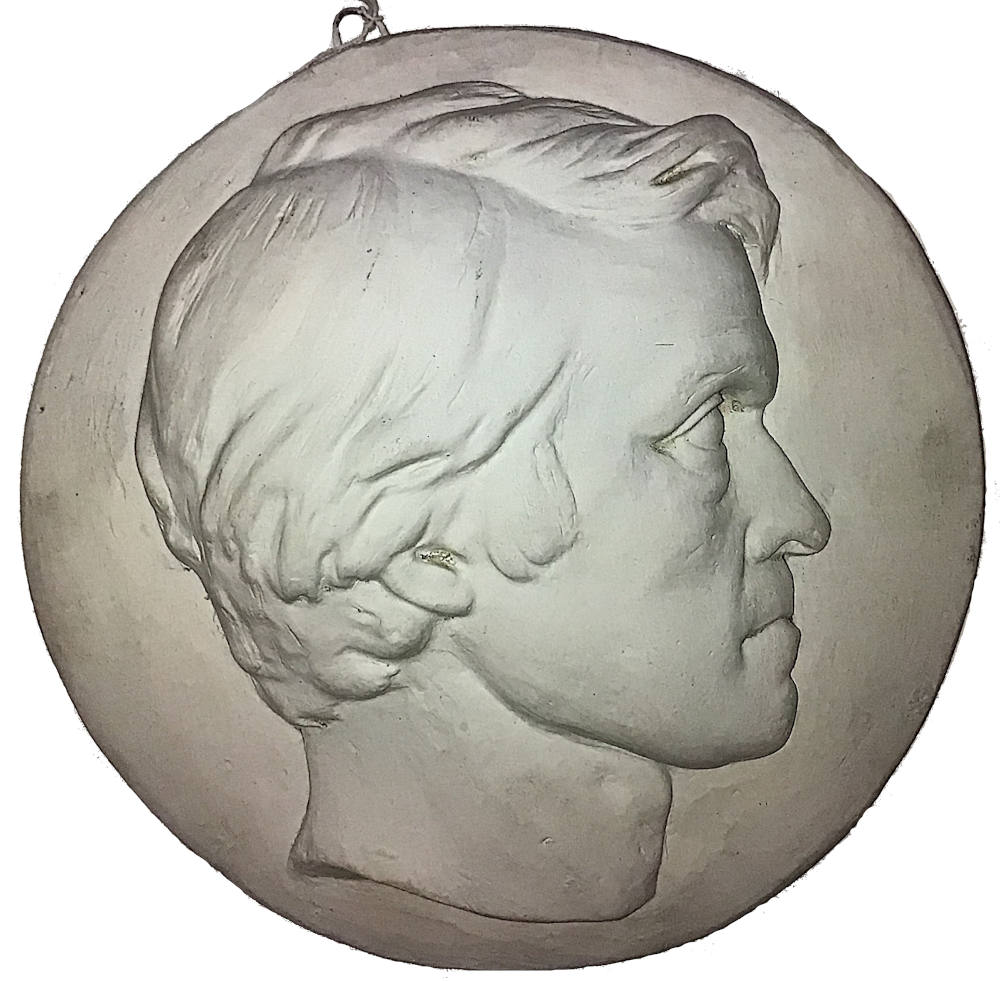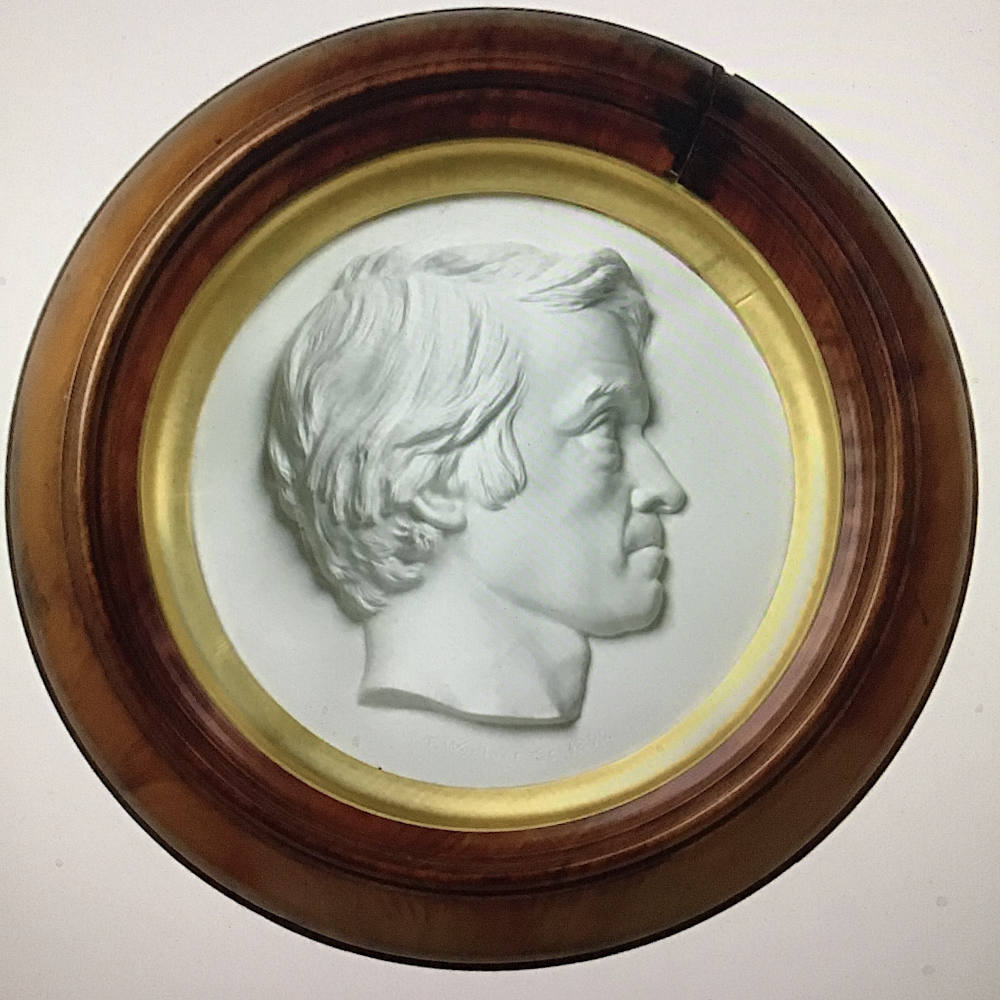

Left: Relief Portrait Medallion of Thomas Carlyle. 1851. plaster, 91/8 in. (23 cm) in diameter, unsigned. Collection of Mary Mellish Archibald Memorial Library, Mount Allison University, Sackville, New Brunswick, Canada. Right: . Relief Portrait Medallion of Thomas Carlyle. 1855. Plaster with a wooden surround mahogany frame, signed “T. Woolner Sc 1855,” below the medallion, 91/2 (24.1 cm) in diameter; 137/8 (35.2. cm) in diameter including frame. Private Collection. [Click on images to enlarge them.]
Woolner executed two medallion portraits of the historian and essayist Thomas Carlyle, the first one in 1851 and the second in 1855. Thomas Woolner’s daughter Amy related how the first came about: “Woolner had tremendous admiration for Thomas Carlyle and Mrs. Carlyle, and was anxious to do a medallion of the great writer; and through the kindess of Coventry Patmore, who persuaded Carlyle to sit, he was able to satisfy his desire” (11).
The second medallion of 1855 appears to be just a re-working of the first after Woolner became dissatisfied with his initial version. It was not taken from a second sitting from Carlyle because by that time he had grown a beard. In a letter to William Bell Scott in 1855 Thomas Woolner wrote: “I have made a new one of him [Tennyson], much better than the last; also a new Carlyle, better than the old one.” If one compares the 1851 medallion to the 1855 version there has been definite improvements and refinements, not only in the face but also in the hair and eyebrows. James Anthony Froude (1818-1894), Carlyle’s biographer, thought Woolner’s relief medallion of the writer was the best likeness of Carlyle in the “days of his strength” (459). The re-workings of the Carlyle relief may have come about in part as a result of Woolner’s journey to Australia from 1852-54. After his return to England Woolner was intent on resurrecting his earlier reputation as a sculptor and re-issuing his reliefs of famous men of the period like Carlyle and Tennyson might have proved helpful in this regard. Woolner had exhibited a Medallion of Thomas Carlyle Esq. [no. 1396] at the Royal Academy in 1852, which can be assumed to be the 1851 work. In 1856 he again exhibited at the same venue Thomas Carlyle Esq., [no. 1370] which must be an example of his 1855 medallion.

Relief Portrait Medallion of Thomas Carlyle. 1855. Bronze with a wooden surround walnut frame, signed T. Woolner Sc 1855, below the medallion, 11 ¼ inches (28.5 cm) in diameter including frame. Private Collection.
Woolner exhibited Thomas Carlyle Esq. bronze medallion [1370] at the Royal Academy in 1857. Although Woolner made medallions of other literary figures, such as Wordsworth and Browning, Tennyson and Carlyle seem to have been his most popular reliefs. Although the Carlyle relief portrait casts in bronze and plaster of 1855 are relatively common, the 1851 medallion reliefs are rare and it is unknown how many were issued.
Woolner later modelled a bust of Carlyle in 1865. Plaster casts are in the collections of the Philosophical Institute, Edinburgh, the Observatory, Maxwelltown, and the Kensington Central Library, London. A marble version was executed the following year. When this was exhibited at the Royal Academy in 1868 [no. 1007] W. M. Rossetti commented: “Thomas Carlyle. – the strong, emphatic, penetrating style of Mr. Woolner, who searches under the surface of his sitter’s face, and records on its surface what he has found beneath, gave him the best of rights to deal with such a magnificent head as Carlyle’s – marked as that is by a most powerful dominating expression, with abundant points of subordinate detail and individuality. Mr. Woolner had, indeed, done a medallion of the great writer many years ago; now we get a bust worthily recording so memorable a man”(27). This is likely the bust now in the University of Edinburgh Library.
Related Material
- Plaster in mahogany frame, 9 1/2 inches diameter. Collection Roy Davids Ltd (1999).
- Plaster medallion seen above with label
- Thomas Woolner’s bust of Carlyle at Kensington Central Library (outside the Victorian Web)
- Thomas Carlyle (sitemap)
Bibliography
Froude, James Anthony. Thomas Carlyle: A History of his Life in London 1834-1881. London: Longmans, Green and Co., Vol I, 1884.
Roy Davids Ltd. Manuscripts and Letters, Portraits, Artefacts and Works of Art. Catalogue VI. Great Haseley, Oxfordshire: Roy Davids Ltd, 1999. No. 23.
Rossetti, William Michael. Notes on the Royal Academy Exhibition, 1868. London: John Camden Hotten, 1868, Part I.
Woolner, Amy. Thomas Woolner, R.A. Sculptor and Poet. London: Chapman and Hall, 1917.
Created 14 September 2004
Last modified 27 February 2020